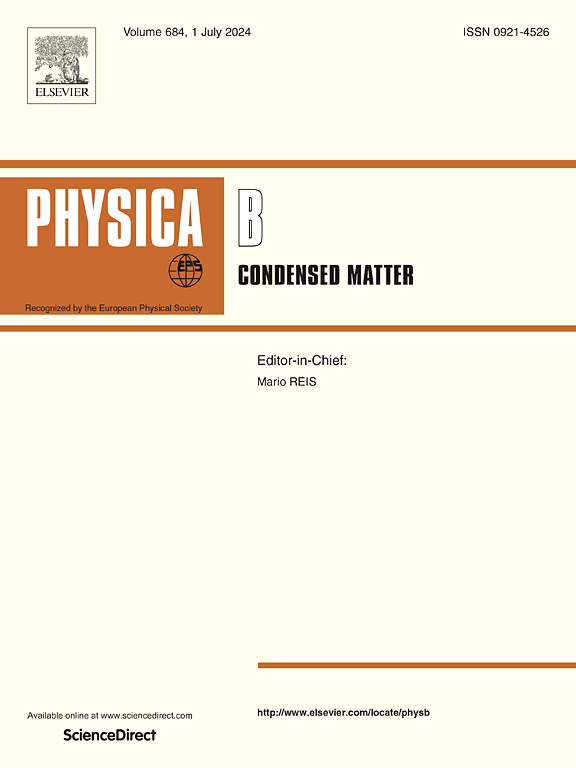用于检测有机化合物的可调宽带二元光子晶体探测器
IF 2.8
3区 物理与天体物理
Q2 PHYSICS, CONDENSED MATTER
引用次数: 0
摘要
在这项工作中,我们从理论上研究了具有插入式空腔层缺陷的一维缺陷光子晶体的反射特性。所提出的一维缺陷层光子晶体传感器的结构是在周期性组织的砷化镓和二氧化硅交替层之间夹有一个空腔层,其结构设计为[(A1A2)3/C/(A1A2)3]。其中,A1、A2 和 C 分别指砷化镓层、二氧化硅层和浸润腔层。插入空腔层由不同的有机化合物(OCC)组成,如戊烷、正己烷、正庚烷和正辛烷。结构参数优化后的反射光谱显示,两个相邻的光子带隙(PBG)被一个反射率为零的缺陷模式隔开。通过将注入空腔区域的有机材料的缺陷折射率提高到 1.39(正辛烷的折射率),缺陷模式波长向更高值移动。研究表明,结构内的局部缺陷模式可以根据化合物的类型检测到微小的折射率变化。随着入射角度的增加,该结构的灵敏度在 θ = 0o 时的 725.5 nm/RIU 和 θ = 80o 时的 1039 nm/RIU 之间变化,当加入的戊烷空腔层厚度为 600 nm 时,灵敏度达到 2672.5 nm/RIU。此外,还计算了品质因数和优点系数,以进一步显示传感能力。与最近发表的作品相比,目前基于一维二元光子晶体探测器的 OCC 生物传感器达到了最高的灵敏度。它表现出了卓越的性能,可用于工业和生化领域的传感应用。本文章由计算机程序翻译,如有差异,请以英文原文为准。
A tunable broadband-binary photonic crystal detector for the detection of organic chemical compounds
In this work, we theoretically investigate the reflectance property of 1D defective photonic crystal with inserted defect of infiltrated cavity layer. The structure of the proposed 1D defect layer photonic crystal sensor consists of a cavity layer sandwiched between alternate layers of GaAs and SiO2 periodically organized and designed as [(A1A2)3/C/(A1A2)3]. With, A1, A2 and C refer to the GaAs layer, SiO2 layer and infiltrated cavity layers, respectively. The insert cavity layer consists of different organic chemical compounds (OCCs) such that Pentane, n-Hexane, n-Heptane and n-Octane. The reflectance spectra with the optimized structural parameters show two adjacent photonic band gaps (PBGs) separated by a defect mode with reflectance zero. By increasing the defect refractive index of the organic materials infiltrated into the cavity region up to 1.39 (refractive index of n-Octane), the defect mode wavelength shifted towards a higher value. It has been shown that the localized defect mode within the structure can detect minute refractive index changes based on the type of chemical compound. By increasing the incident angle the structure exhibited a sensitivity that varies between a 725.5 nm/RIU at θ = 0o and a 1039 nm/RIU for θ = 80o and reached the value of 2672.5nm/RIU at a thickness of 600 nm of incorporated Pentane cavity layer. Also, the quality factor and figure of merit were calculated to show the sensing capabilities further. Compared to recently published works, the current OCC biosensor based on 1D binary photonic crystal detector reached the highest sensitivity. It showed an excellent performance that can be useful for sensing applications in the industrial and biochemical fields.
求助全文
通过发布文献求助,成功后即可免费获取论文全文。
去求助
来源期刊

Physica B-condensed Matter
物理-物理:凝聚态物理
CiteScore
4.90
自引率
7.10%
发文量
703
审稿时长
44 days
期刊介绍:
Physica B: Condensed Matter comprises all condensed matter and material physics that involve theoretical, computational and experimental work.
Papers should contain further developments and a proper discussion on the physics of experimental or theoretical results in one of the following areas:
-Magnetism
-Materials physics
-Nanostructures and nanomaterials
-Optics and optical materials
-Quantum materials
-Semiconductors
-Strongly correlated systems
-Superconductivity
-Surfaces and interfaces
 求助内容:
求助内容: 应助结果提醒方式:
应助结果提醒方式:


